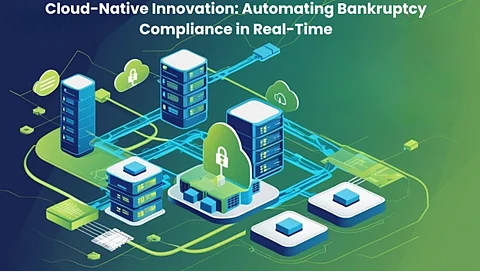

In today’s fast-evolving financial landscape, regulatory compliance demands both speed and precision. Traditional manual methods of monitoring bankruptcy risk are no longer sufficient to meet the growing complexity of legal and operational requirements. Based on the research of Diliprao Boinapally, Senior Software Engineer II at G2 Risk Solutions, this article explores a reference architecture designed to automate bankruptcy monitoring enhancing compliance, reducing risk, and streamlining operations in real time.
Bankruptcy filings can expose financial institutions to regulatory and legal consequences if not detected in time. Traditionally, manual processes dominated the response workflow: employees reviewed court notices, matched debtor data, and initiated account holds. However, this reactive approach was slow, error-prone, and difficult to scale. Boinapally’s architecture addresses this with an end-to-end automated system that accelerates detection while maintaining audit-ready documentation.
At the core of this system is a cloud-native architecture built on three foundational components: serverless workflows, distributed compute clusters, and event-driven orchestration. Serverless modules handle incoming documents and XML parsing without idle resource costs. Distributed engines perform large-scale entity matching with adaptive logic, while orchestration tools such as workflow managers maintain operational flow, error handling, and task dependencies.
This modular design ensures elasticity, capable of scaling horizontally as bankruptcy filings surge during economic downturns, while maintaining high availability and low latency.
Entity matching is the heart of effective bankruptcy monitoring. The architecture integrates deterministic, probabilistic, and machine learning models to resolve identities across various document formats and data qualities. By tuning matching thresholds and incorporating feedback loops, institutions can balance compliance risk with operational accuracy.
A scoring system ranks each case based on regulatory sensitivity, guiding workflow routing and resource allocation. This helps prioritize high-risk events, ensuring timely attention without overburdening teams.
Speed is vital in compliance. The system’s event-driven messaging infrastructure ensures that once a bankruptcy match is detected, alerts are dispatched within seconds. Notifications are customized by role legal teams, account managers, and compliance officers receive only the data relevant to their functions.
Furthermore, the platform supports continuous docket monitoring. It tracks updates like case dismissals, confirmations, or discharge orders and adjusts response protocols accordingly. This proactive monitoring ensures institutions remain aligned with every stage of legal proceedings.
The system integrates seamlessly with account and compliance systems via APIs, allowing immediate status updates and automating necessary actions. Every operation is logged in an immutable audit trail that includes timestamps, user actions, and data transformations. This supports examination readiness and reduces manual overhead in preparing compliance reports.
Templates generate regulator-aligned documentation, enabling self-service evidence collection and simplifying audit responses. Decision paths are fully traceable, offering transparency and accountability throughout the system.
Extensive benchmarks reveal impressive gains over traditional systems. Detection time dropped by 78%, matching accuracy improved by 92%, and document processing throughput rose by over 430% in high-volume scenarios. Notifications that previously took 20 minutes now take under a minute, and automated exception handling resolves the majority of issues without manual intervention.
Even under simulated infrastructure failure, the system maintained 99.97% availability, showcasing its resilience and failover capabilities.
The architecture aligns with diverse financial regulatory frameworks, ensuring automatic stay compliance, secure data handling, and jurisdiction-specific processing. It supports field-level encryption, role-based access, and retention policies tailored to privacy mandates.
Cross-jurisdictional adaptability is built-in, allowing institutions to activate regional modules that define local rules, data requirements, and language support without modifying the core system. This ensures global applicability with local precision.
Beyond bankruptcy detection, the architecture’s modularity opens doors to broader applications. Document pipelines can adapt to suspicious activity reports, sanctions screening, and regulatory change notifications. The event-driven framework is extensible for real-time alerts in multiple compliance domains, fostering a unified approach to governance.
Future directions may include integration with blockchain for tamper-proof documentation, predictive risk modeling, and federated learning for collaborative risk intelligence all while preserving data privacy.
In conclusion, the shift toward cloud-native systems marks a pivotal evolution in regulatory technology for the financial sector. Institutions that embrace this transformation stand to gain significant operational advantages and improved risk oversight. Diliprao Boinapally’s framework sets a new standard for scalable, real-time compliance systems across financial institutions. By fusing automation with adaptability, it lays the groundwork for next-generation compliance solutions that are proactive, resilient, and globally relevant.
